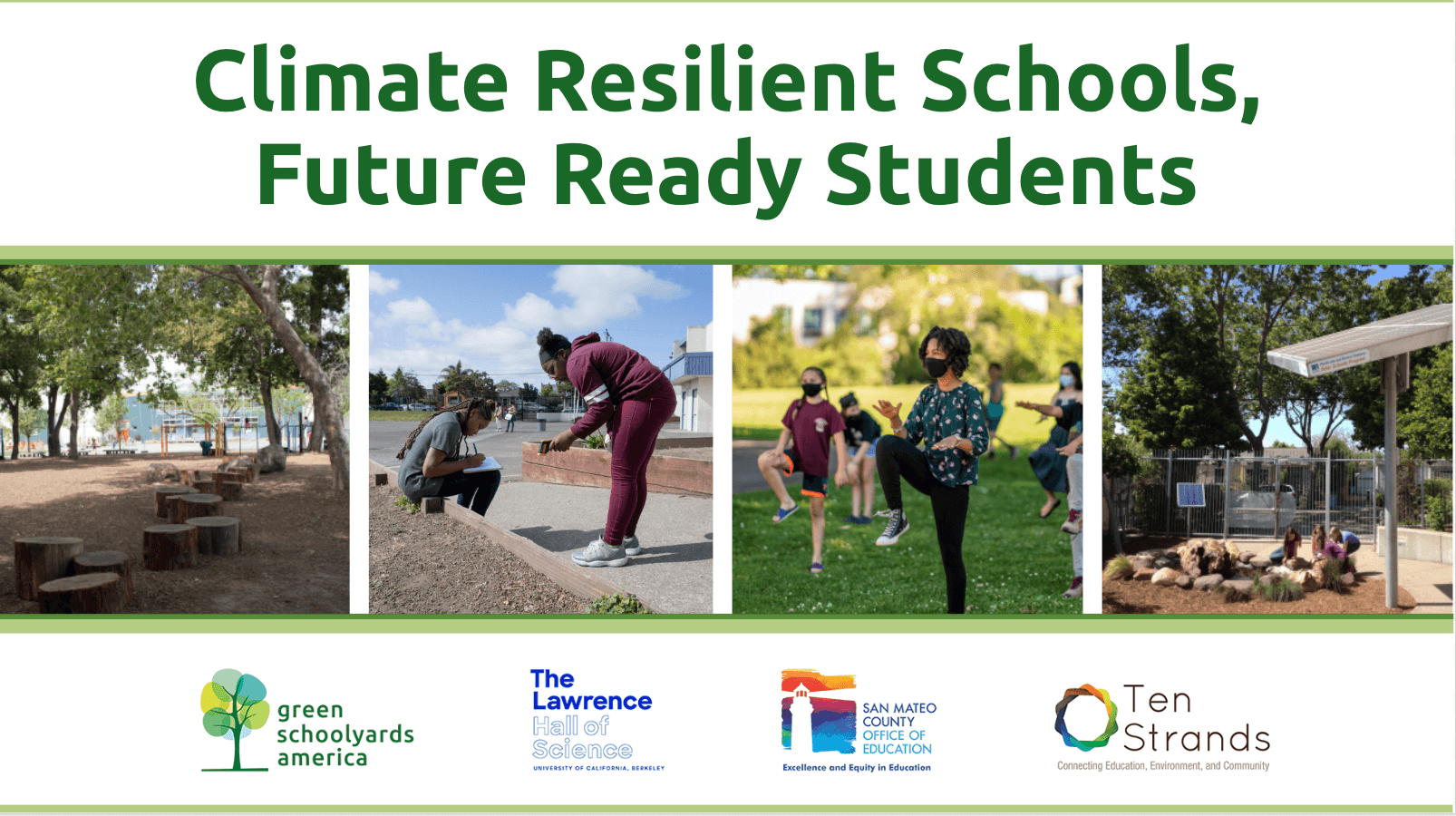When the National COVID-19 Outdoor Learning Initiative (NCOLI) was launched at the height of the pandemic in 2020, it sought to stem the inequities in education exacerbated by COVID-19. Two years later, founding partners Ten Strands, Green Schoolyards America, the Lawrence Hall of Science, and San Mateo County Office of Education are considering the impact of the initiative and assessing how to advance the work to achieve true systemic change.
With that in mind, Ten Strands CEO Karen Cowe, Sharon Danks of Green Schoolyards America, Craig Strang of The Lawrence Hall of Science, and Andra Yeghoian of the San Mateo County Office of Education, led a March panel at SXSW EDU in Austin, Texas, “Climate Resilient Schools, Future Ready Students.”
We spoke to the group about the next steps for NCOLI, the future of outdoor learning, and appearing at SXSW.
Why was it important to present at SXSW and what was the overall objective?
Karen: SXSW EDU is an incredible platform that brings together a lot of great minds for potential collaboration. NCOLI was a great success, but it was also just the tip of the iceberg. We wanted to examine how we can ultimately grow the work to create systemic change in the education system and its relationship to the outdoors.
Craig: After these two years of intensive efforts, we’re asking ourselves, how can we take this further? How can we continue this momentum and this energy? And how can we think about that in the context of the big elephant in the room – climate. The panel discussion was really an exploration of what we have learned and how we can improve.
Andra: For me, it was important to help make the connection between two crises: COVID-19 and the climate crisis. I thought it would be important to present and share that there is so much to be learned from how we responded to the COVID crisis, and despite the differences, there is much that can be applied and expanded on.
Sharon: I wanted to illustrate the relationship between school grounds and the educational environment. We want school grounds to get more systemic investment. To realize the potential to inspire children to be the thriving centers for learning, public health, and community access to nature and open space.
Taking a step back, why was it so vital to create NCOLI?
Karen: We were watching this move to distance learning, and we were worried about the exacerbation of inequities in the education system. There are approximately 6 million students in California public schools and about 30% of them within the first six months of the pandemic still did not have access to high-speed internet. And that access disproportionately impacted students of color. There was a great need to be met.
What was the impact of the launch?
Karen: We created guidance to help schools and districts move classes and programs outside – this included a substantial free online library that includes more than 200 tools and articles. We launched the Emergency Schoolyard Design Volunteers. Overall, more than 5,400 hours donated by more than 210 people. All of this attracted a great deal of media attention: the initiative was mentioned in 1,110 media outlets.
With all that success, what were the greater challenges that NCOLI revealed?
Craig: We achieved a proof of concept but got nowhere near systemic change. We learned that partnerships between community-based organizations and school systems are really challenging. Schools are often most concerned with operations – buses, custodians, clogged toilets, cafeterias, curriculum adoptions and large-scale assessments. And often a smaller fraction of time among leaders is spent thinking about teaching and learning. In that way, it amplified some of the complications.
How did you find the challenge of creating systemic change unique?
Craig: In many cases, in education, the reason something isn’t successful is because there wasn’t enough money. In this case, money was not an obstacle. There are resources available for this type of implementation. It’s not that expensive. So what will it take to respond to this crisis, the climate one, and the next one that’ll come after that? How do we create consensus solutions that actually address the acute needs of communities of color first? What would it take for outdoor learning to be the normal scenario rather than the extraordinary solution that we have a case study about? Those are the questions that we’re thinking about as we’re trying to apply what we’ve learned to a new collective impact effort focused on climate change.
In what ways are COVID-19 and the climate crisis different, and what does that teach us?
Andra: Both are paradigm shifting crisis, but there are some pretty significant differences between the two. COVID is largely an acute crisis, meaning that it is a short term crisis. Whereas, climate change is a chronic long-term crisis that has been building overtime, it has many different causes, and therefore the solutions to mitigate are complex to implement. The threats and impacts are also very different. With COVID, the direct impact is illness, with other secondary impacts like economic disruption with shutdowns, etc. With climate, the impacts are extremely varied and based on disasters such as flood, fire, heat, etc. Each one of these has their own response, and each one has a number of secondary impacts. Another difference between the two is that COVID causes lockdowns and climate disasters cause migrations. The last thing is that climate threatens all life, not just humans. Despite all these differences, we have learned that living schoolyards are a critical part of what it means for a school community to be resilient during a crisis.
What is the relationship between schools and the climate crisis?
Andra: Schools are an extremely important leverage point for the hearts and the minds of our culture. And so our kids need to be learning about the climate crisis, and how they and their school community can be a part of that solution. We also need to elevate the critical relationship between the campus, teaching and learning (curriculum), and community and culture. In my work at the county level, we are constantly reinforcing this relationship, and supporting districts to develop environmental literacy and climate action plans (we refer to them as Sustainable and Climate Ready Schools Action Plans). Our goal with these plans is to catalyze transformational change, but to build that momentum through incremental actions that can be outlined in a clear plan.
Why are school grounds so vital to educational equity and quality?
Sharon: Nearly 50 million K-12 students across the country attend school every day on thousands of square miles of public land, and many offer very little to improve the wellbeing of students, their communities, or the environment. Our school grounds are outdated – most were designed in the 1940s and the practices of that time. Curricula today include hands-on place-based learning and requires appropriate settings and resources to support it. Nature-rich school grounds have the potential to connect every child with the natural world, every day.
What does the term ‘Living Schoolyards’ mean and why is it important?
Sharon: They are richly layered park-like environments that strengthen local ecological systems and climate resilience while providing place-based hands-on learning resources for children and youth of all ages. They are places that are designed to increase the joy, laughter, and happiness of all community members and particularly students of all ages. And they are places that can have green infrastructure that’s developed to comprehensively shift impact the schools are having on the environment around them. When implemented comprehensively and citywide, living schoolyards can be an effective green infrastructure, helping their cities address many environmental issues while providing children with physical activity and serving their social-emotional well-being.


